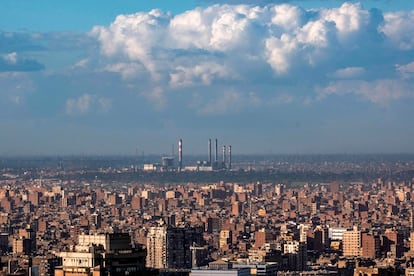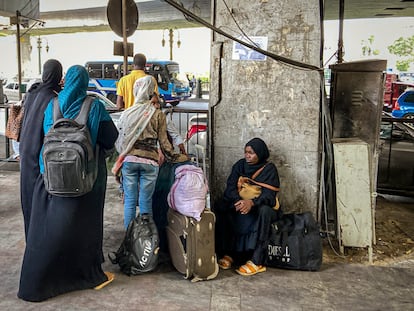Egypt’s gas dream languishes
Domestic consumption and production problems have increased dependence on Israel to export energy to Europe

In 2018, Egypt became self-sufficient in natural gas, four years after finding the largest gas field in the Mediterranean off its north coast. As a result, authorities began to fantasize about an even more ambitious possibility: taking advantage of its two liquefaction plants to become a regional hub for the trade in liquefied natural gas (LNG).
The potential to make Egypt’s dream come true was also given a boost with the start of the war in Ukraine and the European Union countries’ rush to cut their reliance on Russian gas. In the summer of 2022, aware of the opportunity that was opening up before their eyes, the Egyptian authorities even announced a plan to reduce electricity consumption, especially for lighting and public buildings, to enable the country to export as much gas as possible.
The money began to flow just when the state coffers needed it most. Egypt’s finances had been on the ropes due to a serious economic crisis that the war itself accelerated. In the second half of 2022 (the last period for which there is data available), natural gas was far and away Egypt’s main export and generated revenues of almost $5 billion, according to the country’s central bank.
A year later, however, Egypt has found itself in a very different position. Faced with a suffocating heat wave that affected the whole Mediterranean basin this summer, Egypt has not only had to stop its gas exports, but has been forced to impose daily power cuts.
Without any warning and seemingly randomly, the first power outages began to occur at the end of July, just when temperatures were approaching or exceeding 40 °C (104 °F). Faced with utter disbelief among the populace, the Egyptian authorities finally came out to explain themselves with their usual crisis management strategy: assure the public that everything was under control and that the blackouts would end soon, perhaps in a matter of days.
On condition of anonymity to be able to speak more freely, a resident of a central Cairo neighborhood explains: “When the power cuts [started] I was surprised and thought it was only happening in my area, until I saw on social media that it was all over Egypt. It was strange, because we suddenly discovered that we have problems, without prior warning.”
After the deadline that the authorities had set for themselves, the government addressed the Egyptians again with less optimistic news, and announced that the cuts would be extended until September. Since then, Cairo has suffered blackouts for one hour a day, but outside the cities they have been longer and more frequent, according to local media.
In addition to the stifling heat, the power outages have come as the country is going through a harsh economic crisis that is hurting many Egyptians. Since March 2022, its authorities have devalued the local currency three times, which has already lost half of its value against the dollar, and inflation was almost 40% in August, a historical maximum.
The distribution of the power outages has also drawn criticism because they appear to have hit the poorest and most rural parts of the country the hardest. Likewise, the blackouts have not affected either the tourist resorts in the coastal areas of Egypt or the summer vacation homes of its upper classes under the pretext that, like exports, they represent an important source of income for the government.
“At first we didn’t even know the reasons [for the blackouts]. But it is not fair that we Egyptians have to stay and suffer on the hottest days of the year because the government has decided to export [natural gas],” says the former Cairo resident.
Although taking the pulse of the citizens in a country as closed as Egypt is not possible, some analysts believe that the blackouts and the government’s erratic management of the situation have increased social unrest with the president, Abdel Fattah el-Sisi, a few months before he is due to announce whether he will seek a mandate for another six years. Since he took power a decade ago, el-Sisi has swung big on infrastructure development, at a very high cost for Egyptians: foreign debt has increased by more than 300%.
Star field
Although the dissonance between the government’s rhetoric on gas exports and the power cuts has generated surprise among some, others saw it coming. And, although the authorities have tended to ignore it, Egypt has had gas production problems since 2021, especially in Zohr, its star field. And to this is added high domestic consumption, which in the decade after 2011 increased by nearly 30% and today is barely covered by local production.
“Having seen last summer how close Egypt came to recording a domestic gas deficit without including Israeli gas imports, it wasn’t really very surprising to see this year’s shortage, given historically high rates of decline [in production] among their gas fields and the growing trend of increasing [domestic] consumption,” says Peter Stevenson, an expert on the Eastern Mediterranean at the Middle East Economic Survey, a publication specialized in the energy industry.
Despite this, Egypt’s LNG exports increased by 7% in 2022, with more than 80% heading to Europe, according to the oil ministry. This growth parallel to production problems was possible thanks to the country’s two liquefaction plants operating at maximum capacity, the greater use of fuel oil in power plants, and domestic rationing. But all this would have been of little use if it had not been for the imports of Israeli gas that Egypt then re-exports. During 2022, these increased by 48.5%, and have remained very high in 2023.
Therefore, the prospects of Cairo halting its decline and being able to make its natural gas dream come true are rather slim right now. And they depend largely on discovering other deposits such as Zohr or on neighboring countries that do have vast reserves, such as Cyprus and especially Israel, exporting more through Egypt. For the moment, however, both countries are still weighing their options.
Sign up for our weekly newsletter to get more English-language news coverage from EL PAÍS USA Edition
Tu suscripción se está usando en otro dispositivo
¿Quieres añadir otro usuario a tu suscripción?
Si continúas leyendo en este dispositivo, no se podrá leer en el otro.
FlechaTu suscripción se está usando en otro dispositivo y solo puedes acceder a EL PAÍS desde un dispositivo a la vez.
Si quieres compartir tu cuenta, cambia tu suscripción a la modalidad Premium, así podrás añadir otro usuario. Cada uno accederá con su propia cuenta de email, lo que os permitirá personalizar vuestra experiencia en EL PAÍS.
¿Tienes una suscripción de empresa? Accede aquí para contratar más cuentas.
En el caso de no saber quién está usando tu cuenta, te recomendamos cambiar tu contraseña aquí.
Si decides continuar compartiendo tu cuenta, este mensaje se mostrará en tu dispositivo y en el de la otra persona que está usando tu cuenta de forma indefinida, afectando a tu experiencia de lectura. Puedes consultar aquí los términos y condiciones de la suscripción digital.
More information
Últimas noticias
Most viewed
- Sinaloa Cartel war is taking its toll on Los Chapitos
- Oona Chaplin: ‘I told James Cameron that I was living in a treehouse and starting a permaculture project with a friend’
- Reinhard Genzel, Nobel laureate in physics: ‘One-minute videos will never give you the truth’
- Why the price of coffee has skyrocketed: from Brazilian plantations to specialty coffee houses
- Silver prices are going crazy: This is what’s fueling the rally











































